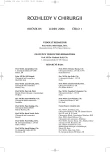Contemporary Approach to Treatment of the Posttraumatic Empyema of the Thorax
Authors:
F. Vyhnánek; J. Fanta; D. Jirava; M. Očadlík
Authors‘ workplace:
MUDr. F. Vyhnánek, CSc.
; Chirurgická klinika Fakultní nemocnice Královské, Praha, přednosta doc. MUDr. J. Fanta, DrSc.
; Traumatologické centrum Fakultní nemocnice Královské Vinohrady, Praha, vedoucí lékař doc.
Published in:
Rozhl. Chir., 2006, roč. 85, č. 1, s. 14-18.
Category:
Monothematic special - Original
Overview
Introduction:
Empyema of the thorax is a serious morbidity and mortality causative factor in the postoperative period in severe blunt and penetrating thoracic injuries. The posttraumatic empyema of the thorax results, primarily, from secondary infections of the haemothorax. Current therapeutic management of the posttraumatic empyema of the thorax depends on the disease stage.
Aim:
A retrospektive analysis of the treatment procedures in patients with posttraumatic empyemas of the thorax.
Material, Methods, Results:
A study group included 118 patients with empyemas of the thorax, who were operated during the period from 1996 – June 2005. The commonest type of the empyema was a parapneumonic empyema, present in 86 (73%) subjects. 15 (13%) patients were operated for posttraumatic empyemas of the thorax. In 13 (11%) patients the empyema followed elective intrathoracic procedures (lung or oesophagus resection). In 4 (3%) cases the empyema resulted from intraabdominal inflammatory disorders. The cause of the posttraumatic empyema of the thorax was a secondary infection following repetitive drainages for the pneumothorax in three patients, infection of the retinated haemothorax in two patients and infection of the pleural exudate from a subphrenic absces following a stab injury of the abdomen in one patient. Another patient developed empyema as a complication of the oesophagus perforation by a foreign body. 8 injured patients with ventilation pneumonias developed parapneumonic empyemas. The patients were indicated for surgeries. Videothoracoscopic procedures (VTS, VATS) proved successful in 4 injured patients with empyemas, stage II. Thoracotomy with decortication was conducted in the remaining 11 injured patients (in 3 of them as aVTS conversion). The postoperative course following the decortication in the injured group with the posttraumatic empyema was complicated by a protracted air leak with a partial pneumothorax in two subjects and by a relaps of the pleural exudate in one operated subject.
Conclusion:
1. Open thoracotomy with empyemectomy and decortication is a standard treatment method in the thoracic empyema, grade III.
2. The videothoracoscopic procedures (VTS, VATS) are indicated in early forms of the grade II of the disorder.
3. The quality and the result of the therapy depend on the following:
the management of the focus of the infection, as well as a sufficient lung expansion while the residual pleural cavity is being minimized and also the management of the air leak from the lung.
Key words:
posttraumatic empyema of the thorax – surgical treatment
Labels
Surgery Orthopaedics Trauma surgeryArticle was published in
Perspectives in Surgery

2006 Issue 1
Most read in this issue
- Biliary Reflux in a Reflux Disorder of the Oesophagus
- The Glomus Caroticum Tumor – an Unusal Case
- Gas in the Portal and Mesentrial Venous Bed in a Vascular Ileus
- Safe Distance of the Inferior Resection Line in the Rectal Carcinoma Surgery
